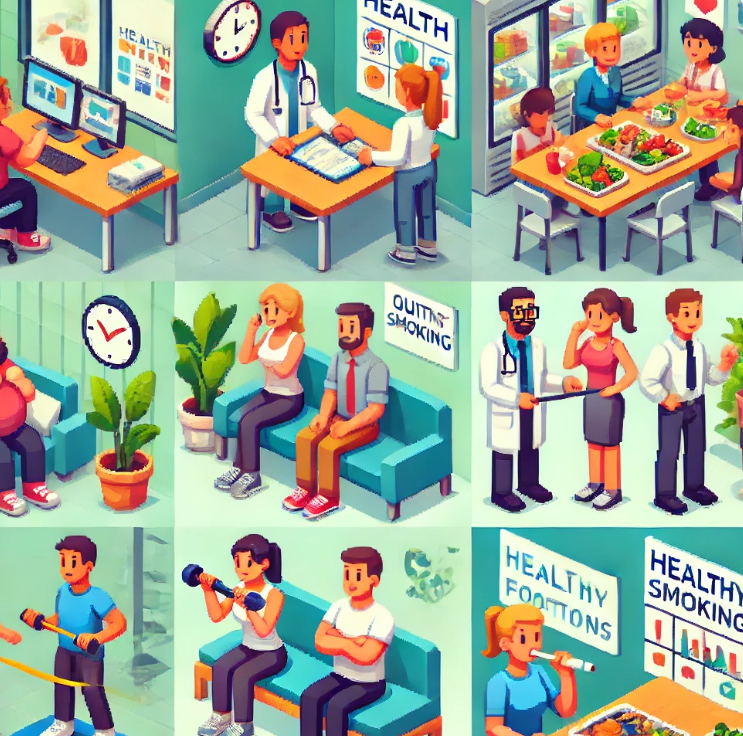
A Path to better Workplace Health
In today’s fast-paced world, many of us spend a significant portion of our lives at work. This makes the workplace an ideal setting for promoting health and preventing chronic diseases. Imagine if your job could help you stay healthier, live longer, and enjoy a better quality of life. That’s the vision behind workplace health promotion. A recent scientific review outlines key strategies for achieving this goal, offering practical solutions that benefit both employees and employers.
The History of Workplace Health
Workplace health and safety have come a long way. During the Industrial Revolution, hazardous conditions and long hours were the norm. Over time, labor unions and government regulations improved workplaces. Today, technology and ergonomics continue to enhance safety, but new challenges have emerged. Many workers face lifestyle-related diseases like obesity and diabetes, partly due to sedentary jobs and unhealthy habits.
The Power of the Workplace
Because workers spend so much time at their jobs, workplaces have a huge potential to influence health. By promoting healthy behaviors and providing support, employers can help prevent chronic diseases and improve overall well-being. Here are some key areas where workplace health promotion can make a difference:
Health Screening: Catching Problems Early
Regular health screenings at work can identify risks for diseases like hypertension and diabetes before they become serious. For example, measuring blood pressure and blood sugar levels can reveal hidden problems. Early detection allows for timely intervention, which can prevent severe health issues and reduce time off work due to illness.
Tobacco Cessation: Kicking the Habit
Smoking is a major risk factor for many diseases. Workplaces can support tobacco cessation by offering counseling and nicotine replacement therapies like gum and patches. Group sessions led by ex-smokers or health professionals can provide motivation and support. Smoke-free policies at work further encourage quitting, creating a healthier environment for everyone.
Healthy Eating: Fueling Better Choices
Unhealthy eating is a leading cause of obesity and related health problems. Workplaces can promote healthier choices by providing nutritious food options and educating employees about balanced diets. Simple changes, like offering discounts on healthy meals or labeling healthy options, can make a big difference.
Physical Activity: Moving More, Feeling Better
Physical inactivity is linked to many health issues, including heart disease and diabetes. Encouraging employees to be more active can improve their health and productivity. This can be as simple as promoting walking meetings, providing standing desks, or organizing fitness challenges. Microexercise, such as short strength-training sessions using resistance bands, can be especially effective.
Routine Vaccination: Protecting Against Disease
Vaccinations are crucial for preventing infectious diseases. Workplaces can play a role by offering free on-site vaccinations for illnesses like flu and hepatitis. Informing employees about the benefits of vaccines and making them easily accessible can increase coverage and protect the entire workforce.
Implementing Workplace Health Programs
Successfully promoting health at work requires involvement at all levels—employees, employers, and health professionals. The SWOLE model outlines the necessary steps:
- Society: Support from public health authorities and policies that encourage workplace health initiatives.
- Workers: Engagement and participation in health programs.
- Organization: Creating a supportive environment and culture that values health.
- Leaders: Commitment from top management to prioritize health.
- Environment: Physical and social environments that promote healthy behaviors.
Why Public Health Practitioners Should Care
Public health practitioners play a vital role in promoting workplace health. By collaborating with businesses, they can extend their reach and impact. Healthier workplaces lead to healthier communities, reducing the burden on healthcare systems and improving overall public health.
Let us know in the comments!
- How has your workplace supported or hindered your efforts to live a healthier lifestyle?
- What health initiatives would you like to see implemented at your job?
Be a Health Innovator – Get Weekly Updates!
Stay informed and active. Subscribe for free and share this blog to make a difference in public health.
About the Author
Dr. Jonathan P. Scaccia, PhD, is a clinical-community psychologist with expertise in public health science and practice. He has led evaluation and research initiatives focusing on health equity, vaccine distribution, and organizational readiness. Dr. Scaccia has contributed to federal suicide prevention programs and vaccine equity strategies. He has been recognized for his impactful work and is a leading voice in advancing public health practices.



